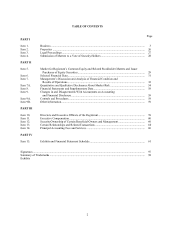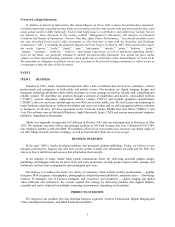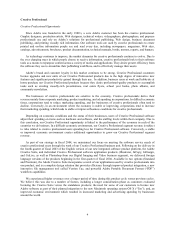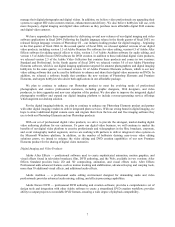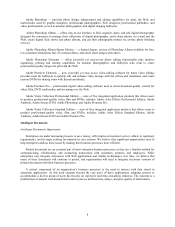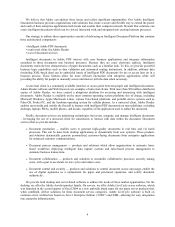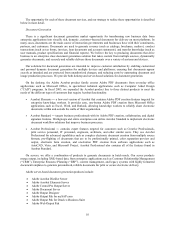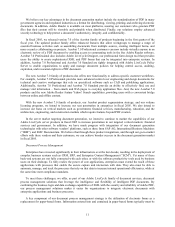Adobe 2004 Annual Report Download - page 12
Download and view the complete annual report
Please find page 12 of the 2004 Adobe annual report below. You can navigate through the pages in the report by either clicking on the pages listed below, or by using the keyword search tool below to find specific information within the annual report.12
manually retyped and entered into enterprise applications, which is inefficient, error-prone, and labor-intensive.
With our solutions for document process management, the enterprise’s customers, employees, and partners can
instead submit information through secure electronic forms. By embedding business logic (such as calculations and
data validation) into these forms, our solutions can also improve the accuracy of data that is automatically integrated
into core business systems such as CRM, ERP, and ECM enterprise applications.
In addition, information captured in an electronic form can trigger rules- and roles-based workflow. For
example, an employee can enter data on-line into an expense report that is submitted electronically for approval; the
data can then be automatically sent to a manager for review, or integrated into the organization’s accounting system.
Additional process tracking and reporting capabilities offer business managers insight into the status of their
workflows, and allow them ways to further streamline their processes for better business performance.
Our document process management solutions involve several desktop products, including the Adobe Acrobat
product line, Adobe Reader and Adobe LiveCycle Designer. Our solutions also include server-based software such
as Adobe LiveCycle Forms, Adobe LiveCycle Reader Extensions Server, and Adobe LiveCycle Workflow Server.
Together, these products offer the broadest range of solutions for deploying intelligent forms that can be completed
online or offline, across diverse platforms and devices.
In the second quarter of fiscal 2004, we acquired privately held Q-Link Technologies, a leading innovator in
business process management software. The acquisition enhances our document process management capabilities by
providing Java-based workflow technology that is being integrated with our Intelligent Document Platform.
In addition, during fiscal 2004 we introduced our Adobe LiveCycle Barcoded Forms solution to automate the
capture of user-supplied data from interactive Adobe PDF forms using 2D barcode technology. Our new solution
helps bridge the paper-to-digital divide; when an electronic form is printed and the 2D barcode on the form is
successfully scanned, data is electronically extracted from the barcode and routed to core enterprise applications. As
a result, Adobe LiveCycle Barcoded Forms can dramatically reduce the costs, errors, and time associated with
manual data entry or OCR-based forms processing solutions.
In fiscal 2005, we intend to continue to market the capabilities of our LiveCycle server products targeting
document process management to achieve increased market share in our targeted vertical markets. As in the
document generation market, we have made progress with integration of our electronic forms technologies with
other software vendors’ platforms, such as those from SAP AG and IBM. We believe that through these product
integrations, and through our go-to-market efforts with these vendors and their customers, we can achieve broader
success in document process management in fiscal 2005.
Document Collaboration
The desire by governments and enterprises to have more effective and timely collaboration solutions has created
a significant opportunity. Collaboration can be a difficult task for an enterprise to accomplish because documents
must flow within and between organizations, yet all participants in review cycles may not have the same
applications or system configurations to support proprietary or specialized document formats. Our solutions for
document collaboration enable more secure and reliable distribution of documents to streamline document
exchange, review, commenting, and approval on most platforms, while protecting content from unauthorized access
and alterations. Adobe PDF documents can also be automatically routed, tracked, and integrated into core
applications such as ECM to manage the full collaboration process.
Benefits to customers using our solutions for document collaboration include the protection of business
information and process integrity, the reduction of costs by automating collaborative processes and reducing paper,
and the simplification of document sharing between employees, customers, partners, and other constituents.
Governments can shorten the time it takes to approve applications. Enterprise customers can replace paper mailings
to customers and suppliers with electronic document distribution, accelerate product and engineering documentation
reviews, and streamline contract review and preparation.
Our products for document collaboration include the Adobe Acrobat product line, Adobe Reader, and Adobe
LiveCycle Reader Extensions Server. Adobe LiveCycle Reader Extensions Server lets enterprises easily share


